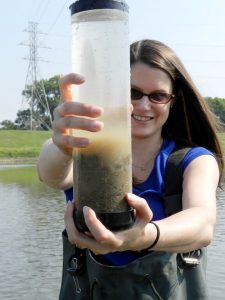
Silvia Newell is an associate professor in the Department of Earth and Environmental Sciences and president of the Lake Erie and Aquatic Research Network. (Photo by Nate Christopher, Fondriest Environmental)
A Wright State University researcher is playing a major role in a new state partnership designed to gauge the effectiveness of wetlands in reducing water pollution.
Ohio Gov. Mike DeWine’s H2Ohio Initiative, a comprehensive, data-driven approach to improving Ohio’s water quality, has enlisted the Lake Erie and Aquatic Research Network (LEARN) to partner with the Ohio Department of Natural Resources (ODNR) on the initiative’s wetland monitoring plan. The group will assess the effectiveness and future role of implemented and planned wetland restoration projects.
“ODNR is charged with managing statewide projects focused on creating, restoring and enhancing wetlands to improve water quality,” said Mary Mertz, ODNR director. “We are working collaboratively with LEARN to draw on the expertise from Ohio’s strong academic institutions to help us document the success of these long-term investments in water quality.”
LEARN President Silvia Newell, an associate professor in Wright State’s Department of Earth and Environmental Sciences, said LEARN is excited to partner with ODNR on the wetland monitoring project.
“We have researchers from six Ohio universities partnering with managers from ODNR, EPA and Ohio Sea Grant, as well as local watershed groups, to ensure we develop a comprehensive monitoring and evaluation plan that can be used as a blueprint for future work,” she said.
LEARN is a group of field stations, scientific laboratories and diverse researchers in Ohio that promotes collaborative research, education and networking to address the challenges and opportunities facing Ohio’s freshwater resources.
“The main challenges we have in water quality right now come mostly from human nutrient pollution, and many studies have shown that wetlands are good at reducing nutrient pollution to our water resources,” said Newell. “The Ohio Department of Natural Resources is trying to get an assessment of how well the wetlands they have invested in are at doing that job.”
Newell said the biggest challenge is that many of the wetlands don’t have a single entry and exit point, which makes assessing the nutrient-reducing efficiency extremely complicated.
“We are fortunate to have such a diverse array of expertise — from geophysicists to remote-sensing specialists to geochemists — to help devise monitoring and assessment plans,” she said.
The group will study different types of wetlands to determine which are the most cost-effective for mitigating nutrient runoff to Ohio waters. The effort will also inform future wetland construction and maintenance.
“The information gained from this unique restoration monitoring program will support management decisions and actions that will not only benefit Ohio and Lake Erie but also ecosystems across the Midwest and Great Lakes,” said Janice Kerns, wetland monitoring program lead for ODNR.
The program’s monitoring plan will enable LEARN researchers from Wright State, Toledo Ohio State, Bowling Green State, Heidelberg and Kent State to sample multiple wetland types either being constructed or planned for the near future. ODNR and state scientists recognize that each wetland type will require different sampling approaches and will likely vary in its capacity to reduce nutrient runoff. This comprehensive monitoring plan is designed to identify and capture these differences.
The effort will use existing monitoring infrastructure such as weather stations and gauges, university resources like Heidelberg’s National Center for Water Quality Research, and existing collaborations with agencies, nonprofit organizations and industry.
“Direct engagement between scientists at Ohio’s universities and agencies will strengthen the state’s ability to monitor and assess how H2Ohio constructed wetlands mitigate nutrient runoff to Ohio’s freshwater systems,” said Kristen Fussell, assistant director of administration and research at Ohio State’s Ohio Sea Grant and Stone Laboratory.
Newell, who earned her Ph.D. in geosciences from Princeton University and held a postdoc position at Boston University, joined the faculty in the Wright State College of Science and Mathematics in 2014. She has worked on biogeochemical cycling of nitrogen in aquatic environments from the Gulf of Mexico and the Arabian Sea to Lake Erie and Lake Taihu in China.
Her work at Wright State focuses on nitrogen as a driver of harmful algal blooms in eutrophic Lake Erie, Lake Okeechobee, Lake Taihu and Estonian lakes, as well as local research on the Great Miami River and Ohio wetlands. She is the president of the Lake Erie Area Research network and the co-chair of the Great Lakes HABs Collaborative.
Newell is interested in the interactions between global climate change, gross human perturbation of the nitrogen cycle and subsequent changes in ecosystem function. Her research combines molecular biology and biogeochemical techniques.

 Museum-quality replica of historic Hawthorn Hill donated to Wright State
Museum-quality replica of historic Hawthorn Hill donated to Wright State  Wright State celebrates more than 1,000 graduates at fall 2025 commencement
Wright State celebrates more than 1,000 graduates at fall 2025 commencement  2026 Alumni Achievement Awards celebrate distinguished Wright State community members
2026 Alumni Achievement Awards celebrate distinguished Wright State community members  Bags, boards and bonding
Bags, boards and bonding  More than 1,000 students to graduate at Wright State’s fall commencement ceremonies
More than 1,000 students to graduate at Wright State’s fall commencement ceremonies 